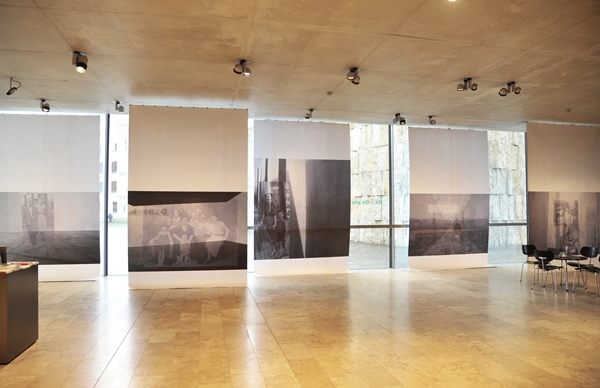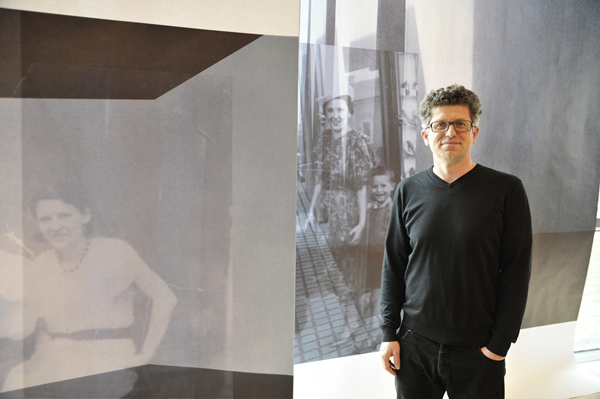At the Jewish Museum in Munich artist Georg Soanca-Pollak presents a remarkable new installation. “Zeitorte” combines photographs of his family before World War II with memorials and monuments of the present
Georg Soanca-Pollak has returned. Six years ago he created the walkable monument in Munich’s newly constructed Ohel Jakob synagogue. His ‘Walk of Remembrance’ connects the synagogue with the community center. Now Pollak is exhibiting his remarkable new installation at the Jewish Museum which is also part of the building complex at the heart of the Bavarian capital.
Huge collages bring memories to life
In ‘Zeitorte’ (Temporal Places), the Romanian born artist presents large format collages in which he combines photographs of his family before World War II with Auschwitz and other memorials and monuments of the present. Various times and places seem to merge throughout the collages reflecting the exhibition’s title.

Soanca-Pollak’s “Zeitorte’ (Temporal Places) combines photographs of his family before World War II with Auschwitz and other memorials and monuments of the present
One image at the center of one of his works shows the artist’s great-aunt and great-grandfather in elegant clothes walking through the Hungarian city of Szeged. Upon closer inspection however, the sidewalk turns out to be the pillars of the Berlin ‘Memorial to the Murdered Jews of Europe,’ the sky above them from Auschwitz. The images were taken by Soanca-Pollak himself.
The artist’s inspiration
The artist drew inspiration from a text penned by the Frankfurt-born publicist Hanno Loewy who writes about his grandfather walking in Galicia in “A Stroll”. The picture shows Loewy’s grandfather with three little girls at his side, his daughters and a niece. The father and his daughters are smiling and relaxed. Some years later he was murdered by the Gestapo.
“When I read Loewy’s text and saw the accompanying photos, I knew I wanted to work with them,” says Soanca-Pollak.
Talking to Loewy and Eva Schloss, Anne Frank’s stepsister and co-founder of the Anne Frank Trust, Soanca-Pollak describes why the photos had such an effect on him. “The aim of the Nazis was to completely wipe out these people, to wipe them out from history. The photographs however, hold them in time and space and preserve the memory.”
Images give memory a face
A recurring element in his work is the number 8020, the number tattooed on his grandmother’s arm in Auschwitz. The numbering at the camps demonstrates how the Nazis literally stole identities, replacing names with faceless numbers. Eva Schloss knows how important images are and how dangerous their prohibition can be during dark times. Ms. Schloss travels around the world to help maintain the memory of her tragically famous stepsister.
She recalls her work in ‘Canada’, the area of the Auschwitz concentration camp where prisoners’ valuables were kept. “Most of them had photos of their loved ones. It was incredibly important to the people to be remembered.”
A clever combination
Photography has also accompanied her in later life. “Anne’s father Otto gave me his camera and encouraged me to become a photographer. I took his advice and practiced for the next 20 years.”
The exhibition, with its clever combination of light-heartedness and the presence of terror, shows how unexpected the catastrophe was which descended upon the Jews of Europe. Too often the victims of the Holocaust remain only abstract names on monuments. Soanca-Pollak’s work gives them a face.
Lorenz Pitum is a freelance journalist based in Munich

